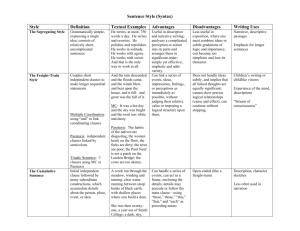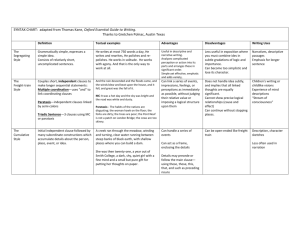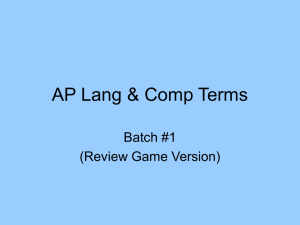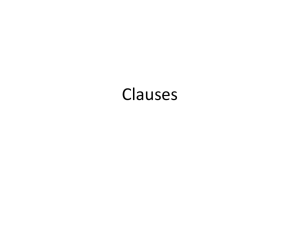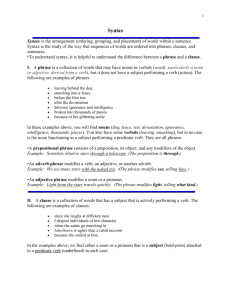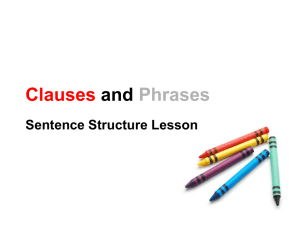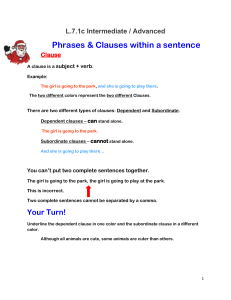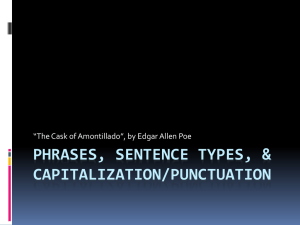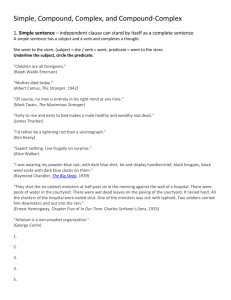Syntax
advertisement
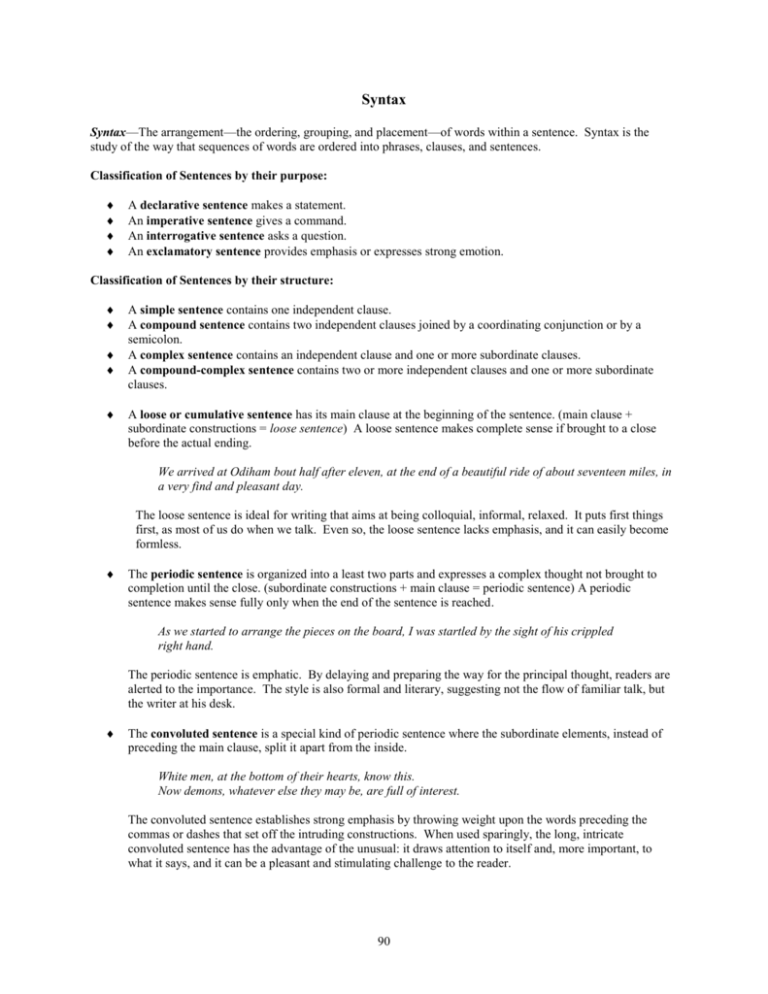
Syntax Syntax—The arrangement—the ordering, grouping, and placement—of words within a sentence. Syntax is the study of the way that sequences of words are ordered into phrases, clauses, and sentences. Classification of Sentences by their purpose: A declarative sentence makes a statement. An imperative sentence gives a command. An interrogative sentence asks a question. An exclamatory sentence provides emphasis or expresses strong emotion. Classification of Sentences by their structure: A simple sentence contains one independent clause. A compound sentence contains two independent clauses joined by a coordinating conjunction or by a semicolon. A complex sentence contains an independent clause and one or more subordinate clauses. A compound-complex sentence contains two or more independent clauses and one or more subordinate clauses. A loose or cumulative sentence has its main clause at the beginning of the sentence. (main clause + subordinate constructions = loose sentence) A loose sentence makes complete sense if brought to a close before the actual ending. We arrived at Odiham bout half after eleven, at the end of a beautiful ride of about seventeen miles, in a very find and pleasant day. The loose sentence is ideal for writing that aims at being colloquial, informal, relaxed. It puts first things first, as most of us do when we talk. Even so, the loose sentence lacks emphasis, and it can easily become formless. The periodic sentence is organized into a least two parts and expresses a complex thought not brought to completion until the close. (subordinate constructions + main clause = periodic sentence) A periodic sentence makes sense fully only when the end of the sentence is reached. As we started to arrange the pieces on the board, I was startled by the sight of his crippled right hand. The periodic sentence is emphatic. By delaying and preparing the way for the principal thought, readers are alerted to the importance. The style is also formal and literary, suggesting not the flow of familiar talk, but the writer at his desk. The convoluted sentence is a special kind of periodic sentence where the subordinate elements, instead of preceding the main clause, split it apart from the inside. White men, at the bottom of their hearts, know this. Now demons, whatever else they may be, are full of interest. The convoluted sentence establishes strong emphasis by throwing weight upon the words preceding the commas or dashes that set off the intruding constructions. When used sparingly, the long, intricate convoluted sentence has the advantage of the unusual: it draws attention to itself and, more important, to what it says, and it can be a pleasant and stimulating challenge to the reader. 90 In a balanced sentence, two or more words or constructions have essentially the same form and length and have similar functions. Visit either you like; they’re both mad. The road lay white in the sun, and the railway ran just beyond. He seemed like a walking blasphemy, a blend of the angel and the ape. We live in an ascending scale when we live happily, one thing leading to another in an endless series. Balance requires that the sentence divide into roughly equal halves on either side of a central pause—not necessarily always two independent clauses as the first two examples. Balanced elements may be played against one another, sometimes repeating the same idea, sometimes expressing contrasting ideas. When the contrast is sharply pointed it is called antithesis: antithetical constructions are simply balanced phrases or clauses expressing opposed ideas. Cattiness is a cold war staged by women; macho is a hotter war fought by men. Parallelism means that two or more words, phrases, or clauses have the same grammatical form and an identical grammatical relationship to the same thing. In its energy, its lyrics, its advocacy of frustrated joys, rock is one long symphony of protest. The Department of Justice began a vigorous campaign to break up the corporate empires, to restore the free and open market, and to plant the feet of industry firmly on the road to competition. The parallel style suits the needs of speakers well. It is impressive and pleasing to hear—elaborate yet rhythmic and ordered, following a master plan with a place for everything and everything ordered. It is also economical. In its fullest development the parallel sentence has something of the grandeur of a great building, and this architectural impressiveness gives weight and dignity to what the sentence says. Inverted word order means rearranging the main elements of a sentence in some order other than subjectverb-object, which is often called natural word order. Inversions almost always draw attention and is used for emphasis. Him Nature solicits with all her placid, all her monitory picture; him the past instructs; him the future invites. Juxtaposition is a poetic and a rhetorical device in which normally unassociated ideas, words, or phrases are placed next to one another, often creating an effect of surprise or wit. The rhetorical question is a question that requires no answer. It is used to draw attention to a point and is generally stronger than a direct statement. Yet this need not be. The means are at hand to fulfill the age-old dream: poverty can be abolished. How long shall we ignore this under-developed nation in our midst? How long shall we look the other way while our fellow human beings suffer? How long? Repetition is a device where words, sounds, and ideas are used more than once to enhance rhythm and to create emphasis. o Anaphora is the repetition of the same term beginning successive clauses. I didn’t like the swimming pool, I didn’t like swimming, and I didn’t like the swimming instructor, and after all these years I still don’t. 91 o Antistrophe is the repetition of the same term at the ending of successive clauses. When that son leaves home, he throws himself with an intensity which his children will not know into the American way of life; he eats American, talks American, he will be American or nothing. o Anadiplosis is using the same term at the end of one clause at the beginning of the next one. To philosophize is to understand; to understand is to explain oneself, to explain is to relate. o Epanalepsis is when the same word appears at the beginning and the end. Problem gives rise to problem. Polysyndeton and Asyndeton—are two different ways of handling lists or items in a series. Traditionally a comma follows each item in the list with a conjunction (and) between the last two. Polysyndeton places a conjunction after every term except the last. Asyndeton uses no conjunctions and separates terms of the series with commas. Where the conventional series emphasizes no particular item, though the last usually seems a bit more significant, in polysyndeton the emphasis falls more evenly upon each member of the list. It is the season of suicide and divorce and prickly dread, whenever the wind blows. In asyndeton the series takes on more significance as a whole than it does in the conventional pattern. But the stress on each individual item is lighter than in polysyndeton, and the passage moves more quickly. His care, his food, his shelter, his education—all of these were by-products of the parents’ position. Examine sentence length. Sentences shorter than five words are called telegraphic, approximately eighteen words in length medium, and thirty or more words long. The short sentence is inherently emphatic. If well constructed, it is clear, concise, and convincing. It will seem especially strong in the context of longer, more complicated statements. Often the contrast in length reinforces the contrast in thought. The first premise of the college elective system is that the subjects and courses of curriculum are of approximately equal value. Well, they are not. Sometimes the positions of the key terms are reversed, a rhetorical device called chiasmus or antimetabole. If there had never been a danger to our constitution there never would have been a constitution to be in danger. Books are among the best of things, well used; abused, the worst. Zeugma is a special kind of pun involving a verb. It occurs when the one verb has two different meanings with objects that complement both meanings. She left his apartment with tarnished virtue and a new mink. Joanna, pursued by the three monks, ran about the room, leaping over tables and chairs, sometimes throwing a dish or a scriptural maxim at her pursuers. Zeugma, like puns in general, is a comic figure of speech. At its best zeugma is witty and amusing, and it increases meaning by revealing hidden connections. 92

